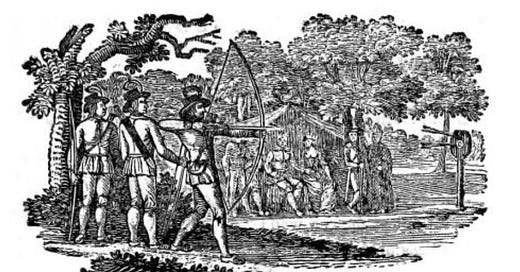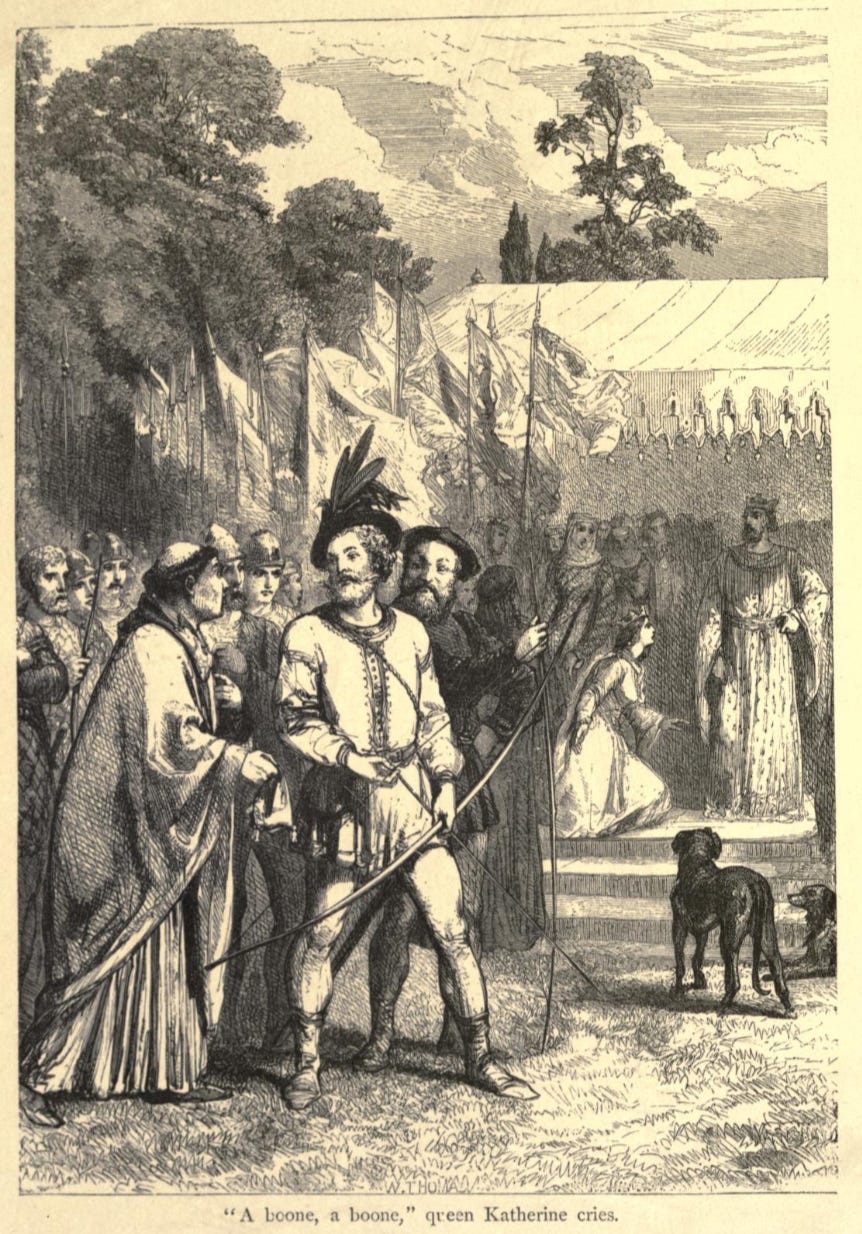ROUD 72: Robin Hood and Queen Katherine
AKA: Renowned Robin Hood, His Famous Archery Truly Related, Robin Hood and Queen Catherine
Preamble: Thanks to everyone who has ordered the Sing Yonder 1 compilation album so far, it’s been wonderful to see the support out there for it, and hear tracks from it played on numerous radio shows and podcasts. If you want to hear it yourself, go and grab yourself a copy from here.
And now onto the main event - it’s the one you’ve all been waiting for:

Another episode in the Robin Hood saga (and you might be relieved to hear, the last for a long while); this time our titular outlaw and his merry men save three lads from the gallows. I think this is another fine demonstration of the reason that Robin Hood ballads never took off in the oral tradition. As mentioned in the last episode, the best selling anthology of Robin Hood Ballads “Robin Hood’s Garland” was most likely produced for the genteel middle classes to read for a bit of lighthearted escapism. This would have contributed to their relatively sanitised subject matter - no-one is murdered or raped, for example, and everyone escapes unscathed apart from a little hurt pride. This is in stark comparison to the murder ballads much historically performed in pub singarounds, and around traveller campfires, where there was seemingly a sense of competition in relating the bleakest story possible, much in the manner of the tabloid newspapers today.
So apologies to those who love a bit of death and mayhem, all you will find here is heroic, selfless deeds and a happy ending. And at the start, Robin Hood robs the King and gives it to the poor …. *check’s notes* … no, sorry, he gives it to the Queen. Oh well.
Music
Official recordings of this are as far as I’m aware non-existent, so there’s no playlist. Instead I commissioned the English folk specialist and all round excellent chap Matt Quinn to create something for us. Here it is, and very good it is too - I really enjoyed learning and singing it for the guide recording. Thanks Matt.
Some Sources
It won’t surprise anyone to learn that this ballad has not been studied in tremendous depth in its own right, but there have been a few mentions of note, normally within larger studies of the Robin Hood legend as a whole.
For those who enjoy the parlour game of “pin the historical figure on the ballad character”, the Royal participants of the song, King Henry and Queen Katherine lead some to believe that the ballad author wished to associate the tale with Henry VIII and Catherine of Aragon - popular figures in songs of the time in which the ballad may well have been written. See for example:
Other Henrys that have been suggested links to the ballad include Henry II, Henry V, and even King Henry II of France who married Catherine de' Medici. All of this would be made easier were there a date range in which the legend of Robin operated was fixed - unfortunately for fans of specificity, latter day Medievalists seem to be of the opinion that “Robin Hood” was nothing more than a common nom de guerre for many generations of medieval outlaws, making it a legend that spans centuries, and no doubt contributed to its longevity.
Francis Child’s commentary is always worth a read. Like the piece above, he references (among other things) the mention of “Loxly” in the ballad; a name often associated with Robin Hood, as his possible birth place. Whether this refers to the Loxley Valley around Sheffield (well known to fans of well known resident Jon Boden, whose apocalyptic nu-folk concept albums are based around there), or possibly Locksley Town in Nottinghamshire, is still up for debate. Those who wish to claim Robin for their own will do so regardless, I suspect.
The Medieval Studies department of the University of Rochester, New York has an excellent ballad website. Their page on this ballad is well worth reading, mainly for the extensive footnotes, which provide commentary and context of far greater pedigree than most places, very much including here.
Draft pages and Audio guide
Keep reading with a 7-day free trial
Subscribe to Sing Yonder: A Practical Guide to Traditional Song to keep reading this post and get 7 days of free access to the full post archives.





